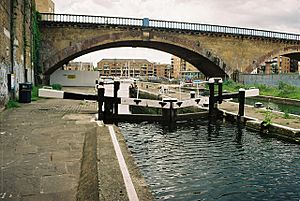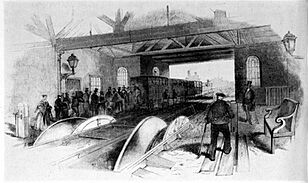London and Blackwall Railway facts for kids
The London and Blackwall Railway (L&BR) was an important railway line in east London, England. It started as the Commercial Railway and connected the City of London to Blackwall and the Isle of Dogs. This railway was very useful for linking the city to many of London's docks in Poplar.
The L&BR carried passengers from 1840 until 1926. It continued to carry goods until 1968. The railway eventually closed because the docks in inner London became less busy. Today, much of its old route and structures are used by the Docklands Light Railway, which is a modern train system. The L&BR was managed by the Great Eastern Railway from 1866, but it stayed its own company until 1923. In 1871, another part of the railway, called the Millwall Extension Railway, was opened.
Contents
History of the Railway
The idea for this railway became official with a special law called the Commercial Railway Act 1836. This law was passed on 28 July 1836. It allowed for a railway to be built from Minories to Blackwall, with some smaller lines branching off. The railway was planned to be about 3.25 miles (5.2 km) long.
The first engineer for the project was supposed to be John Rennie the Younger. However, the people funding the railway preferred Robert Stephenson. They hoped to benefit from the knowledge of his famous father, George Stephenson. Robert Stephenson had to follow the route Rennie planned. He also had to use an unusual track width of 5 feet 0.5 inches (1,537 mm). But he could choose how the trains would move. He decided to use a system where stationary steam engines pulled the trains with cables.
The railway was built on brick arches for most of its length, especially near the West India Docks. Then it ran on a raised bank before going into a shallow cut near the Blackwall station. The station at Blackwall had a special iron roof and offices designed in an Italian style.
The railway opened on 6 July 1840. The company changed its name to the London and Blackwall Railway in 1841. This happened after the line was extended to Fenchurch Street, which was closer to the heart of London. By 1848, the railway switched from using cables to steam locomotives. This was because the ropes wore out faster than expected. Also, new extensions were planned for 1849.
A new line was opened in 1849 from Stepney (now Limehouse) to Bow. This was called the London and Blackwall Extension Railway (LBER). At this time, the railway was changed to use steam trains. The track width was also changed to the standard 4 feet 8.5 inches (1,435 mm).
In 1852, the North London Railway connected with the L&BR at Poplar. This made Fenchurch Street a main station for trains from that line. In 1871, another branch line, the Millwall Extension Railway, opened. It went from Millwall Junction to Millwall Docks to better serve the West India Docks. A year later, this line was extended to North Greenwich.
Why the Railway Closed Down
In 1893, the line between Fenchurch Street and Stepney was made wider, with four tracks. But as the 1900s began, fewer people were using the trains to Blackwall and the Isle of Dogs. To save money, the railway started using special small trains called railmotors in 1922. However, passenger services east of Stepney to North Greenwich and Blackwall stopped on 3 May 1926. This was because more people were using trams instead.
The writer John Betjeman (1906–1984) wrote about his journey on the L&BR in his book First and Last Loves. He described the trains as "frequent and quite empty." He said they "rumbled past East End chimney pots, wharves and shipping." They stopped at "empty black stations" until they reached Blackwall. He remembered that at Blackwall, there was "nothing to see beyond it but a cobbled quay and a vast stretch of wind whipped water."
Some smaller stations like Leman Street and Shadwell closed in 1941 during the war. The connection at Stepney was removed in 1951. This meant the only way to get to the Blackwall Branch was from the LBER. This route was also closed in 1963. Goods trains still used parts of the line until 1968. But when the docks closed, the railway was completely abandoned. Only the Fenchurch Street–Stepney part of the original line is still used today.
When the Docklands Light Railway opened in 1987, it used many parts of the old L&BR line. For example, it used the route between Minories (now Tower Gateway) and Westferry Road. Part of the raised track (viaduct) at North Greenwich was also used.
How Cable Haulage Worked
When it first opened, the railway was about 3.5 miles (5.6 km) long. It had two tracks that worked separately. Each track had a very long rope made of Manila hemp. As an engine pulled the rope from one end, the same amount of rope was let out at the other end. This meant they needed 14 miles (23 km) of rope in total!
Trains left the main station in two groups. The first group of four carriages went to the stations furthest away. The second group went to the stations closer by. Each carriage at the back was unhooked as the train passed its station. When the railway was extended to Fenchurch Street, the carriages for that station were unhooked at Minories. They then rolled up a small slope to the new platforms using their own speed. Attaching and unhooking carriages was done by levers on an open platform at the front of each carriage.
It was too dangerous to pick up carriages on the way back to the main station. So, all the carriages were attached to the cable at their stations. They all started moving at the same time as the train leaving the main station. An early version of the Cooke and Wheatstone telegraph was used to make sure the timing was perfect. The carriages arrived at the main station one after another. A new train was then put together for the return trip. Trains ran every 15 minutes.
Eight large steam engines provided the power for the cables. Four engines were used at a time, and four were kept for maintenance. The engines at Minories were 110 horsepower (82 kW). The engines at Blackwall were smaller, at 75 horsepower (56 kW). This was because the railway sloped downwards from west to east.
The railway switched to using steam locomotives in 1848. This was partly because the ropes wore out too quickly. They even tried steel-wire ropes, but these twisted badly. Also, new railway extensions were planned for 1849. A light roof was built over parts of the line near timber stores or ships. This was to prevent fires from sparks coming from the steam locomotives. After the switch, trains could travel directly between any two stations, which was much more convenient.
Stations Along the Line
Here are the main stations that were part of the London and Blackwall Railway:
| Station | Opened | Closed | Notes |
|---|---|---|---|
| Fenchurch Street | 1854 | Still open today. | |
| Minories (moved) | 1841 | 1853 | |
| Minories (original) | 1840 | 1841 | The site is now used by Tower Gateway. |
| Leman Street | 1877 | 1941 | Closed during World War II. |
| Cannon Street Road | 1842 | 1848 | |
| Shadwell | 1840 | 1941 | Closed during World War II. |
| Stepney | 1840 | Renamed Stepney East in 1923, then Limehouse in 1987. Still open. | |
| Limehouse | 1840 | 1926 | Not the same as the current Limehouse station. |
| West India Docks | 1840 | 1926 | |
| Millwall Junction | 1871 | 1926 | |
| Poplar | 1840 | 1926 | On a different site from the current Poplar DLR station. |
| Blackwall | 1840 | 1926 | On a different site from the current Blackwall DLR station. |
The London and Blackwall Extension Railway branch to Bow from Stepney (opened 1849) had these stations:
- Burdett Road (opened 1871, closed 1941)
- Bromley and Bow (1849–1850)
- Bow Road (first station 1876–1892, second station 1892–1949)
- Victoria Park & Bow (opened 1849, closed 1850)
The Millwall Extension Railway branch to North Greenwich from Millwall Junction had these stations:
- South Dock (opened 1871, closed 1926)
- Millwall Docks (opened 1871, closed 1926)
- North Greenwich (opened 1871, closed 1926; not the same as the current Underground station)



